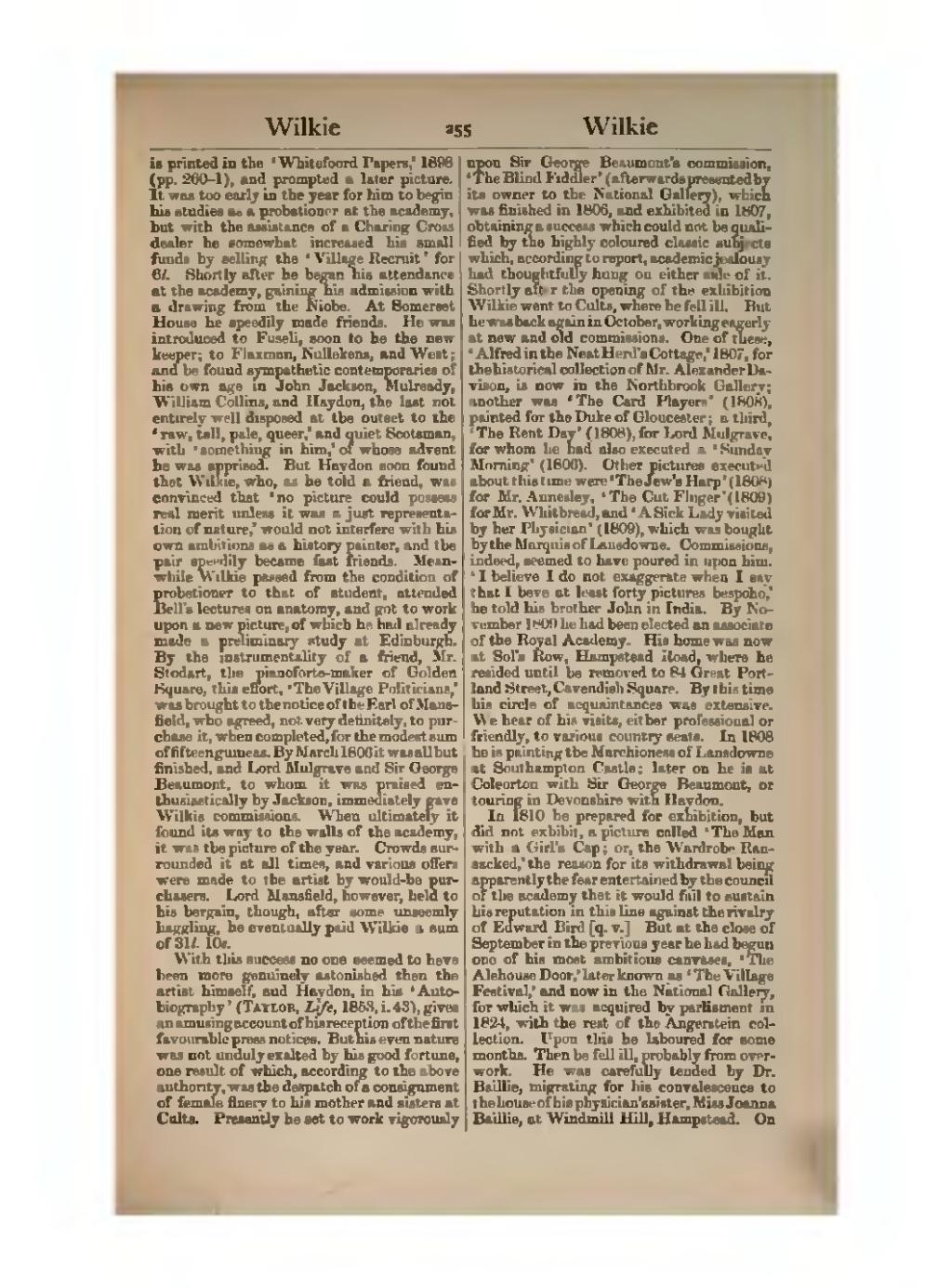is printed in the ‘Whitefoord Papers,’ 1898 (pp. 260–1), and prompted a later picture. It was too early in the year for him to begin his studies as a probationer at the academy, but with the assistance of a Charing Cross dealer he somewhat increased his small funds by selling the ‘Village Recruit’ for 6l. Shortly after he began his attendance at the academy, gaining his admission with a drawing from the Niobe. At Somerset House he speedily made friends. He was introduced to Fuseli, soon to be the new keeper; to Flaxman, Nollekens, and West; and he found sympathetic contemporaries of his own age in John Jackson, Mulready, William Collins, and Haydon, the last not entirely well disposed at the outset to the ‘raw, tall, pale, queer,’ and quiet Scotsman, with ‘something in him,’ of whose advent he was apprised. But Haydon soon found that Wilkie, who, as he told a friend, was convinced that ‘no picture could possess real merit unless it was a just representation of nature,’ would not interfere with his own ambitions as a history painter, and the pair speedily became fast friends. Meanwhile Wilkie passed from the condition of probationer to that of student, attended Bell's lectures on anatomy, and got to work upon a new picture, of which he had already made a preliminary study at Edinburgh. By the instrumentality of a friend, Mr. Stodart, the pianoforte-maker of Golden Square, this effort, ‘The Village Politicians,’ was brought to the notice of the Earl of Mansfield, who agreed, not very definitely, to purchase it, when completed, for the modest sum of fifteen guineas. By March 1806 it was all but finished, and Lord Mulgrave and Sir George Beaumont, to whom it was praised enthusiastically by Jackson, immediately gave Wilkie commissions. When ultimately it found its way to the walls of the academy, it was the picture of the year. Crowds surrounded it at all times, and various offers were made to the artist by would-be purchasers. Lord Mansfield, however, held to his bargain, though, after some unseemly haggling, he eventually paid Wilkie a sum of 31l. 10s.
With this success no one seemed to have been more genuinely astonished than the artist himself, and Haydon, in his ‘Autobiography’ (Taylor, Life, 1853, i. 43), gives an amusing account of his reception of the first favourable press notices. But his even nature was not unduly exalted by his good fortune, one result of which, according to the above authority, was the despatch of a consignment of female finery to his mother and sisters at Cults. Presently he set to work vigorously upon Sir George Beaumont's commission, ‘The Blind Fiddler’ (afterwards presented by its owner to the National Gallery), which was finished in 1806, and exhibited in 1807, obtaining a success which could not be qualified by the highly coloured classic subjects which, according to report, academic jealousy had thoughtfully hung on either side of it. Shortly after the opening of the exhibition Wilkie went to Cults, where he fell ill. But he was back again in October, working eagerly at new and old commissions. One of these, ‘Alfred in the Neat Herd's Cottage,’ 1807, for the historical collection of Mr. Alexander Davison, is now in the Northbrook Gallery; another was ‘The Card Players’ (1808), painted for the Duke of Gloucester; a third, ‘The Rent Day’ (1808), for Lord Mulgrave, for whom he had also executed a ‘Sunday Morning’ (1806). Other pictures executed about this time were ‘The Jew's Harp’ (1808) for Mr. Annesley, ‘The Cut Finger’ (1809) for Mr. Whitbread, and ‘A Sick Lady visited by her Physician’ (1809), which was bought by the Marquis of Lansdowne. Commissions, indeed, seemed to have poured in upon him. ‘I believe I do not exaggerate when I say that I have at least forty pictures bespoke,’ he told his brother John in India. By November 1809 he had been elected an associate of the Royal Academy. His home was now at Sol's Row, Hampstead Road, where he resided until he removed to 84 Great Portland Street, Cavendish Square. By this time his circle of acquaintances was extensive. We hear of his visits, either professional or friendly, to various country seats. In 1808 he is painting the Marchioness of Lansdowne at Southampton Castle; later on he is at Coleorton with Sir George Beaumont, or touring in Devonshire with Haydon.
In 1810 he prepared for exhibition, but did not exhibit, a picture called ‘The Man with a Girl's Cap; or, the Wardrobe Ransacked,’ the reason for its withdrawal being apparently the fear entertained by the council of the academy that it would fail to sustain his reputation in this line against the rivalry of Edward Bird [q. v.] But at the close of September in the previous year he had begun one of his most ambitious canvases, ‘The Alehouse Door,’ later known as ‘The Village Festival,’ and now in the National Gallery, for which it was acquired by parliament in 1824, with the rest of the Angerstein collection. Upon this he laboured for some months. Then he fell ill, probably from overwork. He was carefully tended by Dr. Baillie, migrating for his convalescence to the house of his physician's sister, Miss Joanna Baillie, at Windmill Hill, Hampstead. On
